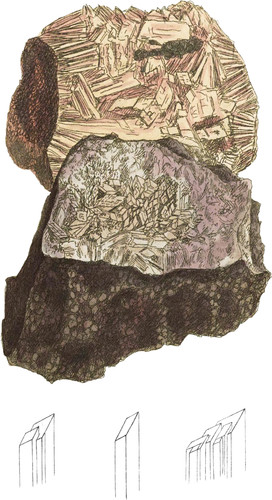 Enlarge
Enlarge
British Mineralogy
Laumonite
- Class 2. Earths.
- Ord. 1. Homogeneous.
- Gen. 4. Silex.
- Spec. 16. Laumonite.
- Syn.
- Zeolithe efflorescente? Haüy Traité, 4. 410.
- Laumonite. Haüy Tabl. 49.
- Lomonit. Werner.
- Laumonite. Bournon in Trans. of Geo. Soc. 1. 90.
This substance is so well treated of in a memoir of the Count de Bournon’s in the Transactions of the Geological Society, vol. 1. p. 77, that I think it sufficient to take most of my description from it, while I do not deprive those that have an opportunity to indulge in reading the excellent original. It appears to have been formerly known as Efflorescent Zeolite, but Werner termed it Lomonit, in honour of M. Gillet de Laumont, to whom we are indebted for the first knowledge of it. The former name was given it in consequence of its disintegrating or falling into powder by exposure to the air.
The Count determines the primitive crystal to be a tetraëdral prism with rhombic bases, the sides meeting at 92° 30′ and 87° 30′: the bases are inclined upon the edges of 92° 30′ so as to form with them angles of 55° and 125°: the height of the prism is to the edge of the terminal faces in the ratio of 8 to 7. It divides in a direction parallel to all its planes, but more easily longitudinally than on its terminal surfaces: the longitudinal division takes place more easily on two of its opposite skies than on the two others. Integrant molecule a slightly rhomhoidal tetraëdrat prism; it is besides divisible parallel to its axis, and to the greater diagonal of its rhombic terminal planes. Fracture lamellar. Spec. Grav. taken with a piece but slightly changed by exposure, 22,34*. Hardness, when not changed, sufficient to cut glass with case. Electricity by friction, none. Reducible to a jelly by the action of acids. Fusible by the blowpipe without addition, with a slight ebullition, affording an opaque white enamel. Mostly disintegrating on exposure to a warm atmosphere, which may be partly prevented by gum or varnish, or by keeping in distilled water. Colourless and transparent when fresh, but in altering, becomes more opaque; shining and pearly on the longitudinal faces of the prism.
Found mixed with a lamellar Carbonate of Lime, which is highly phosphorescent when heated, producing a bright orange light.
Laumonite is almost always in a crystallized state. It was found at Huel goet in Lower Brittany twenty years ago, by M. Gillet de Laumont, but the Count now rinds it to occur in other places. He has specimens from the Island of Feroe, also from the Venetian States: some coveting Prehnite, dull and pulverulent, from China. It occurs also with Slilbite and Analcime at Port Rush; in I he county of Antrim in Ireland: and the friendly Mr. R. Phillips, a few years since, brought fine specimens from Paisley in Renfrewshire; thus it is found to be a British mineral, and these latter specimens are here figured by Mr. P’s favour; and I congratulate myself that my friends will be pleased that it is thus added to the British Catalogue, not the first, and I presume not the last of many which have been, or will be added in the short space of time occupied by the publication of this work, I have figured outlines of the more remarkable groupes of crystals that occur upon the specimen. They are all primitive.
The Count enumerates altogether ten modifications and above thirty varieties.
- * Water bring considered as 10,00.

